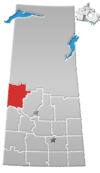
Thunderchild First Nation (Cree: ᑳ ᐱᑎᑰᓈᕽ, romanized: kâ-pitikônâhk) is an independent Cree First Nations band government in Turtleford, Saskatchewan, Canada with no affiliation with any Tribal Council. It is located approximately 113 kilometers northwest of North Battleford. European settlement in 1909 caused the reserve to be moved by the Government of Canada from its original location near Delmas, Saskatchewan to where it now currently resides near Turtleford, Saskatchewan.
The First Nation's population is approximately 1,868 of whom approximately 630 reside on the reserve.
This reserve came about after Chief Piyesiw-awasis's headmen were forced to sign an adhesion to Treaty Six in August, 1879 at Special Area No. 4. Piyesiw-awasis was one of Big Bear's bodyguards until starvation and sickness led his people to adhere to the treaty. However, Piyesiw-awasis did not put his mark to the treaty document.[1]
See also
[edit]References
[edit]- ^ "Office of the Treaty Commissioner". otc.ca. Archived from the original on 2005-02-13. Retrieved 7 December 2023.
Further reading
[edit]"Outside, The Women Cried" by Jack Funk, 1989.
External links
[edit]53°28′28″N 108°52′45″W / 53.47444°N 108.87917°W

Well, that’s interesting to know that Psilotum nudum are known as whisk ferns. Psilotum nudum is the commoner species of the two. While the P. flaccidum is a rare species and is found in the tropical islands. Both the species are usually epiphytic in habit and grow upon tree ferns. These species may also be terrestrial and grow in humus or in the crevices of the rocks.
View the detailed Guide of Psilotum nudum: Detailed Study Of Psilotum Nudum (Whisk Fern), Classification, Anatomy, Reproduction